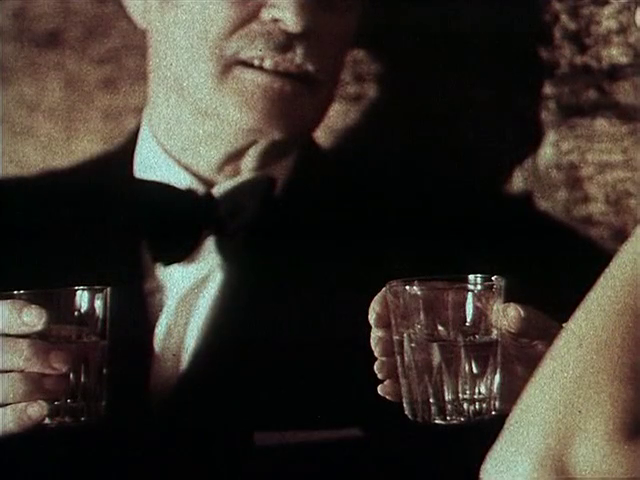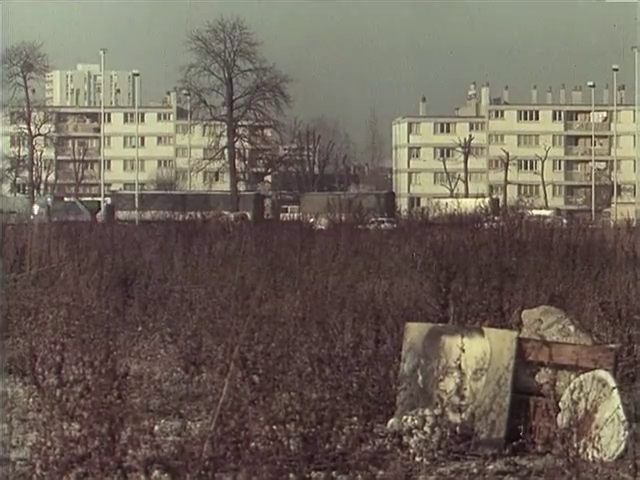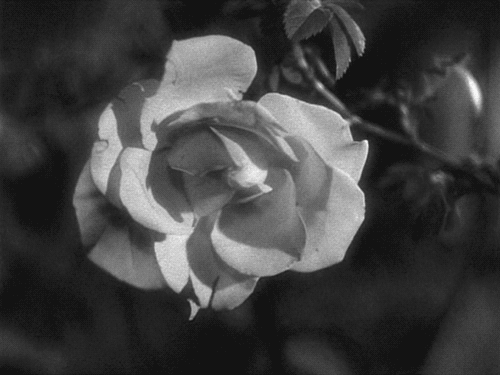“Can we not admit that certain skilled men, gifted with intelligence, talent or even genius, and thus indispensable to society, rather than stagnate, should be free to disobey laws in certain cases?”Pickpocket (Robert Bresson, 1959)
Mar
12

Michel (Martin LaSalle) in a busy café, observing. An emptied water glass next to the thief should make him look like a paying guest. DP: Léonce-Henri Burel.
– Michel
france
Les scélérats [The Wretches] (Robert Hossein, 1960)
Feb
26
canapés

Maid Louise (Perrette Pradier) holding a platter with canapés at a black tie party. Observing her is the master of the house, Jess Rooland (Robert Hossein). DP: Jacques Robin.
Les yeux cernés [Marked Eyes] (Robert Hossein, 1964)
Jan
11
baguette

A young woman with big eyes and a dark bob (Marie-France Pisier) picks crumbs out of a fresh baguette. She's somewhere in a dreary small town. The snow's almost gone. DP: Jean Boffety.
“Time to empty our slop pails and run a little water over our faces, then back to our cells for the entire day.”Un condamné à mort s'est échappé ou Le vent souffle où il veut [A Man Escaped] (Robert Bresson, 1956)
Dec
29
slop

A man's hand holds a spoon at a perpendicular angle. DP: Léonce-Henri Burel.
– Fontaine
Colloque de chiens (1977)
Monique (Silke Humel, R) spending Christmas Eve in a bar, looking for a way out. She's speaking to an elderly man in an expensive tuxedo. Is this it? DP: Denis Lenoir; still photographer Patrice Morere.

December 24: the night before Christmas (Christmas Eve)
Colloque de chiens (Raúl Ruiz, 1977)
“Nobody knows why Monique, the cold and dry voiced whore, bears in her eyes the sadness and tiredness of her past.”
Filmed during an actors' strike, Raúl Ruiz's Colloque de chiens consists for the most part of still photographs with mixed in stolen moving footage of unsuspecting bystanders and stray dogs. Told in fotonovela format, we follow the pitiful account of Monique, who as a young girl, learns that her mother is not who she thinks she is. Rejected, she throws herself into a life of vice until she meets Henri, a handsome young television repairman. Together they buy a small café, and are happy for once. But the cyclical nature of life determines her faith.
Raúl Ruiz's work is, like Henri's modus operandi, determined by maps and patterns. Even in the short comically melodramatic breathe of Colloque de chiens, the map has been laid out for Ruiz's later, much more complex narrative.
Colloque opens in a barren landscape. There are the skeletal towers of a nearby city, and the endless barks of abandoned dogs. Obscured by tall reeds, a blown-up photograph of a young man. The face, soft and familiar, a distant memory.
“He wanted to be returned to the world of his childhood and to this woman who was perhaps waiting for him” –Chris Marker, dialogue from La Jetée (1962)
Amongst bare winter bushes a large photo of a friendly, young, familiar looking man. In the background against a grey sky multiple white apartment buildings.

#Bales2023FilmChallenge #RaúlRuiz #SilkeHumel #EvaSimonet #RobertDarmel #JorgeArriagada #DenisLenoir #PatriceMorere #drama #crime #melodrama #ShortFilm #photography #animals #gender #prostitution #France #1970s ★★★★☆
“We'll go back to Nice tomorrow. The Bay of Angels brings us luck.”La baie des anges [Bay of Angels] (Jacques Demy, 1963)
Dec
23
pears

A blonde Moreau at a restaurant table with a man seen from the back. There are several semi-empty wine glasses and pears sliced lengthwise on a plate, covered with a napkin. Jeanne's character Jackie Demaistre is holding a small sheet of paper with a schematic drawing of a roulette wheel while throwing the man a sceptical glance. DP: Jean Rabier.
– Jean Fournier
“Have you seen Mr Tavernier tonight?”Ascenseur pour l'échafaud [Elevator to the Gallows] (Louis Malle, 1958)
Dec
13
croissants

Mr Tavernier (Maurice Ronet) taking a bite out of a croissant while dialling a number in a lively French café. A blonde behind him shows an interest. DP: Henri Decaë.
“You know Mum, I don't have to write to Santa anymore. There's an easier way, through Minitel.”3615 code Père Noël [Deadly Games / Dial Code Santa Claus] (René Manzor, 1989)
Dec
4
Santa's List Day

A man in a grey overcoat and yellow scarf at a public Minitel terminal. On the display the code 3615 and an 8-bit illustration of Santa Claus carrying his bag with presents. The sack holds a smaller Minitel device with the text PERE NOEL. DP: Michel Gaffier.
A letter to Santa on Santa's List Day (USA)
Aah France… Land of old wine, old cheese, old art, and Internet access in the early 80s. Prestige project of Président Giscard, France was determined to take a technological leap. Any French man, woman and child could borrow a Minitel – a PC-like videotex device – from the national telecommunications services. For those without landline there were numerous public terminals throughout the land. The machine gave the people access to a phonebook (convenient!), the news (smart!), same-day delivery shopping(!) and sexting (ooh la la!). All these services were accessible via a code starting with 3615 followed by a string of letters. Dial 3615 ULLA to text with a sexy lady – some telecom employee pretending to be one – and 3615 PERE NOEL for Santa Claus. The real one, of course.
9 year old whizkid Thomas (Alain Lalanne aka Alain Musy) is dead set on proving that Santa is real and not some weirdo looking for a gullible kid to play with. A trap is set, and the boy waits.
– Thomas
3615 code Père Noël is definitely not your cutesy little Christmas romp. The violence is not cartoonish, the bandit is more Manson than moist. The boy's disillusionment in the adults around him is a perfect mirror of “Santa's” lonely attempts to communicate and be accepted. However, Thomas' mom didn't lie about one thing; that seeing Santa on Christmas Eve turns you into an ogre. Or an adult, as the grownups call it.
– Can such miracles really happen?
– You and I are living proof.La Belle et la Bête [Beauty and the Beast] (Jean Cocteau + René Clément, 1946)
Nov
28
Giving Tuesday

The most beautiful flower, a rose, in La Bête's enchanted garden. DP: Henri Alekan.
Someone is given something special for Giving Tuesday (USA)
Just before leaving home for a business trip, a father asks his three daughters what he can bring them as a return gift. The eldest two ask for silly, extravagant things. A monkey! A parrot! The youngest simply wishes the most beautiful flower which the father finds in an enchanted garden, guarded by a terrible beast. And will pay for with his life unless he gives his youngest away to the beast, to die in his place.
#Cocteau and Clément's La Belle et la Bête is of course based on Gabrielle-Suzanne Barbot de Villeneuve's fairy-tale, which on its turn was based on the classic myth of Cupid and Psyche.
L'udienza [The Audience] (Marco Ferreri, 1972)
Nov
14

Amedeo (Enzo Jannacci), a young man with heavy rimmed glasses wrapped in heavy, flowery drapes as if it's a toga, eating late at night. There's an opened can on one of his plates. A sad looking stuffed toy dog hangs out. DP: Mario Vulpiani.